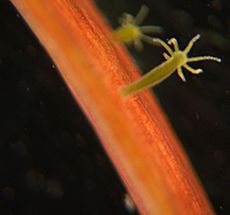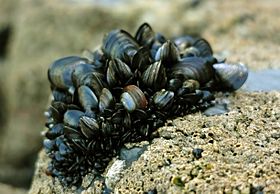Sessility (motility) facts for kids

Sessility is a cool word in biology that describes living things that can't move around on their own. Think of them as creatures that are "stuck" in one spot. They don't have legs or fins to travel. This is different from how plants are described as sessile, which means they don't have a stalk.
Even though sessile organisms can't move themselves, things like water currents can push them around. Many of these creatures are permanently attached to something. For example, corals build their own homes (called a substrate) and grow from there. Other sessile organisms might attach to a rock, a dead tree, or even a boat!
Contents
Life Cycle and Movement
Most animals that are sessile (stuck in one place) during their adult lives actually have a stage where they can move!
- Sponges: When sponges are young, they are tiny larval forms that can swim freely. But once they grow up, they settle down and attach to a surface, becoming immobile.
- Jellyfish: Some jellyfish start their lives as small, sessile polyps attached to the seafloor. Later, they transform into the free-swimming jellyfish we often see.
- Cochineal Insects: These tiny insects are a great example. When they are young (called "crawlers"), they can move around. They find a good spot to feed on a cactus. Later, they produce long, waxy threads. The wind can catch these threads and carry the tiny young cochineals to a new cactus home!
Reproduction
Many sessile animals have interesting ways to make more of themselves.
- Asexual Reproduction: Animals like sponges, corals, and hydra can reproduce without a partner. They often do this by "budding." This is like a small part of the parent growing and then breaking off to become a new, separate organism.
- Spreading Out: Since adult sessile animals can't move, they need a way to send their young to new places. This is why many of them have a mobile larval stage. These tiny larvae can float or swim away from their parents. This helps the species spread out and find new places to live. It also helps them avoid overcrowding.
Clumping Behavior

Clumping is when sessile organisms of the same kind grow very close together. You can see this in places like coral reefs or groups of Blue mussels.
Why do they clump?
- Faster Reproduction: Being close together makes it easier for them to reproduce.
- Better Protection: Living in a big group can help protect them from predators. It's harder for a predator to eat a whole clump than just one individual!
Coastal Homes
Sessile organisms are very common in coastal areas, especially in the circalittoral zone (the part of the ocean near the shore). Places like oyster beds are full of sessile creatures.
Even huge Carbonate platforms (like some islands or underwater mountains) are built up over time by the remains of tiny sessile organisms. These tiny creatures help create new landforms!
Botanical Sessility
In the world of plants, "sessile" means something a little different. When a plant part, like a leaf or a flower, is described as sessile, it means it's attached directly to the main stem or branch without a small stalk (called a peduncle).
See also
 In Spanish: Sesilidad (biología) para niños
In Spanish: Sesilidad (biología) para niños

